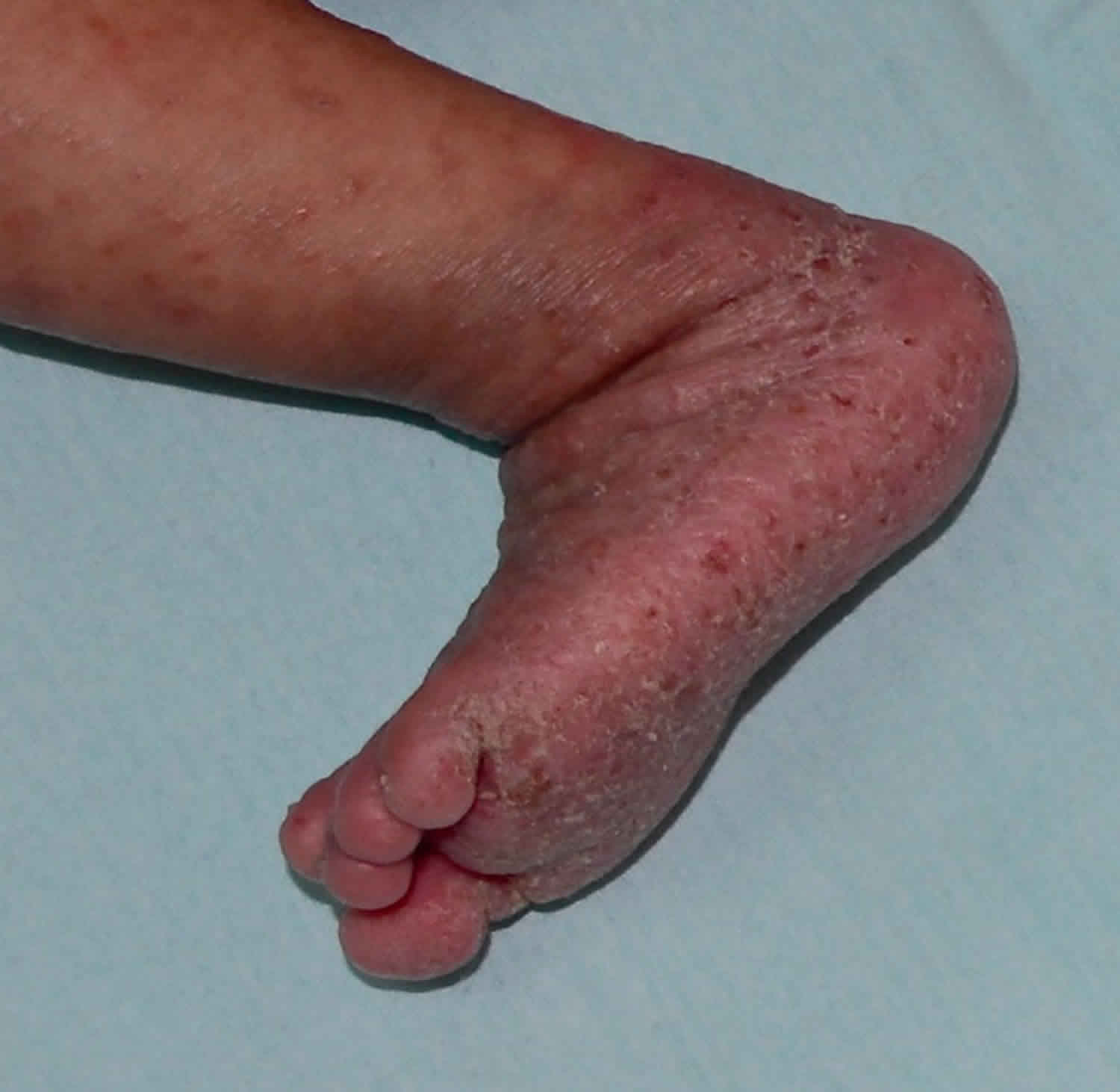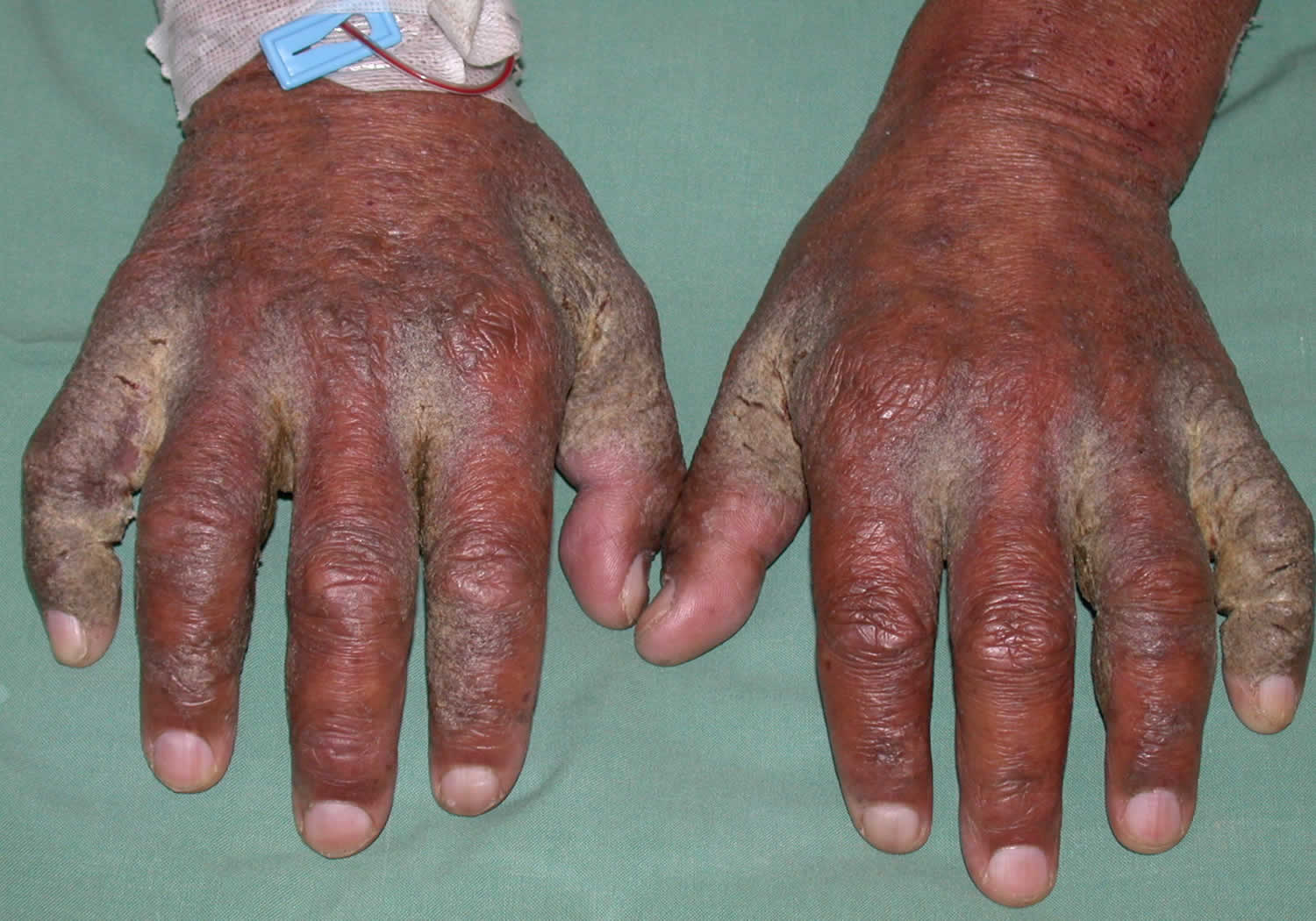Crusted scabies
Crusted scabies also called Norwegian scabies, is a highly contagious hyperinfestation with Sarcoptes scabiei var hominis 1. Crusted scabies is a severe form of scabies that can affect the elderly, persons who are immune compromised or persons who have conditions that prevent them from itching and/or scratching (spinal cord injury, paralysis, loss of sensation, mental debility) 2. Crusted scabies is characterized by vesicles and thick crusts over the skin that can contain many scabies mites 3. Lesions tend to be exaggerated on the soles, palms, ears, and extensor surface of the elbows 4. The crusts may be scaly and loose or adherent and thick 4. On removal of the crust, the skin surface appears smooth, velvety, and red 3. Itching (pruritus) may be absent in crusted scabies because of a patient’s altered immune status or neurological condition 5.
Norwegian crusted scabies was originally described in Norway by Danielssen and Boeck 6 as a type of scabies infestation caused by millions of mites in patients with leprosy. It is estimated that individuals with crusted scabies have up to 4,000 mites per gram of skin 7. Patients are often infected with over 1 million mites. Compare this to the majority of patients with scabies, who are infected with around 10–20 mites. Because patients are infested with large numbers of scabies mites (up to 2 million), persons with crusted scabies are very contagious. Persons with crusted scabies may not show the usual signs and symptoms of scabies such as the characteristic rash or itching (pruritus) 8.
Crusted scabies may also result from misdiagnosis as psoriasis or seborrheic dermatitis and treatment of these disorders.
Crusted scabies is a highly contagious infestation because of the high burden of mites in the epidermis. Early diagnosis is therefore important.
The optimal treatment for crusted scabies has not been subjected to a comparative trial and is generally based on expert opinion 9. However observational data suggest that the use of multiple doses of oral ivermectin as therapy for crusted scabies can lead to a significant decline in mortality 10.
Figure 1. Crusted scabies rash
Crusted scabies causes
The exact reason why crusted scabies arises is unknown. It is associated with elevated eosinophils, immunoglobulin E (IgE) and immunoglobulin G (IgG). The dermis is infiltrated with lymphocytes and eosinophils. There is an increased ratio of CD8+ lymphocytes compared to normal.
Crusted scabies usually occurs in immunocompromised individuals such as those with congenital immunodeficiency disorders (especially cell-mediated immunodeficiency), acquired immunodeficiency syndrome (AIDS)/human immunodeficiency virus (HIV) infection, immunosuppressive treatment (e.g., corticosteroids, calcineurin inhibitors, and cytotoxic drugs), graft-versus-host disease, malignancies (e.g., leukemia and lymphoma), and systemic diseases (diabetes mellitus, systemic lupus erythematosus, dermatomyositis, chronic mucocutaneous candidiasis, and dystrophic epidermolysis bullosa) 11. Other predisposing factors include malnutrition, physical debilitation (senility, sensory or motor neuropathy, leprosy, and paraplegia), and mental retardation (especially Down syndrome) 12.
Norwegian crusted scabies transmission
Scabies is passed on from another individual that is infested by scabies mites. Crusted scabies may arise in people that fail to mount a normal immune response to the mites.
Globally, crusted scabies is most prevalent in remote Aboriginal communities in Northern Australia.
Risk factors for crusted scabies include:
- Increased age
- Dementia
- Down syndrome
- Human immunodeficiency virus infection (HIV)
- Leprosy
- Lymphoma
- Systemic lupus erythematosus (SLE)
- Long-term corticosteroid or immunosuppressant use
- Institutional accommodation – prisons and nursing homes (institutional scabies)
Crusted scabies symptoms
Crusted scabies begins as poorly defined red patches that then develop into thick scaly plaques between the fingers, under the nails, or diffusely over palms and soles. Other common areas include elbows and knees. Mites can also collect in nail beds, causing the nail plates to split.
Itching in crusted scabies may be minimal or absent. This may be due to the immune compromised nature of the individual. The following can contribute to the reduction in scratching:
- Physical limitation
- Neuropsychiatric disorders
- Osteoarticular deformities
- Muscular atrophy
- Loss of cutaneous sensation
Crusted scabies complications
Complications of crusted scabies include:
- Infestation of numerous contacts, including family and staff members
- Secondary bacterial infection
Crusted scabies diagnosis
Scabies is readily diagnosed clinically and confirmed by identification of mites or eggs on dermatoscopic or microscopic examination of burrows. Reflectance confocal microscopy has also been used to examine burrows, mites, eggs and mite feces (scybala). This can be done by carefully removing the mite from the end of its burrow using the tip of a needle or by obtaining a skin scraping to examine under a microscope for mites, eggs, or mite fecal matter (scybala). However, a person can still be infested even if scabies mites, eggs, or fecal matter cannot be found.
Skin biopsy is rarely necessary, and will show characteristic scabies pathology.
Crusted scabies treatment
A dermatologist or infectious disease physician should be involved in the care of the patient and contacts with crusted scabies. Treatment of crusted scabies should be done in an inpatient or residential setting, with the patient in a private room. Healthcare staff should take contact precautions and wear full personal protective equipment, including shoe and hair covers.
Persons with crusted scabies and their close contacts, including household members, should be treated rapidly and aggressively to avoid outbreaks. Institutional outbreaks can be difficult to control and require a rapid, aggressive, and sustained response.
Rooms used by a patient with crusted scabies should be thoroughly cleaned and vacuumed after use. Environmental disinfestation using pesticide sprays or fogs generally is unnecessary and is discouraged.
Treatment is comprised of oral ivermectin and topical insecticides. The following grading system devised at the Royal Darwin Hospital may be used to determine management 1.
A: Distribution
- Wrists, web spaces, feet or < 10% total body surface area
- Above plus forearms, lower legs, buttocks, trunk (10–30% total body surface area)
- Above plus scalp or > 30% total body surface area
B. Crusting/shedding
- Mild crusting (< 5 mm depth of crust), minimal skin shedding
- Moderate (5–10 mm) crusting, moderate skin shedding
- Severe (> 10 mm), profuse skin shedding
C. Past episodes
- Never had it before
- 1–3 prior hospitalizations for crusted scabies or depigmentation of elbows, knees
- ≥ 4 prior hospitalizations for crusted scabies or depigmentation as above plus legs/back or residual skin thickening/ichthyosis
D. Skin condition
- No cracking or pyoderma/impetigo
- Multiple pustules and/or weeping sores and/or superficial skin cracking
- Deep skin cracking with bleeding, widespread purulent exudates
Grade 1: total score 4–6
Grade 2: total score 7–9
Grade 3: total score 10–12
The dose of ivermectin is 200 μg/kg for adults and children over 14 kg, rounded up to nearest 3 mg, and taken after a fatty meal to aid absorption.
- Grade 1: 3 doses – days 0, 1,7
- Grade 2: 5 doses – days 0, 1, 7, 8, 14
- Grade 3: 7 doses – days 0, 1, 7, 8, 14, 21, 28
A topical scabicide is applied every second day for the first week, and then twice a week until cured.
- Permethrin 5% cream or benzyl benzoate 25% emulsion for patients > 6 months of age
- Crotamiton 10% for infants under 6 months
- Sometimes, additional 5% tea tree oil or sulphur ointment
Keratolytic creams are used on scaly plaques on alternate days to scabicide. First, soften crusts in warm water. Then apply either of:
- Salicylic acid 5% to 10% in sorbolene cream
- Lactic acid 5% plus urea 10% in sorbolene cream.
The treating dermatologist or infectious disease physician should carefully re-examine the patient to decide when to stop treatment.
A combination regimen for the treatment of crusted scabies devised by the US Centers for Disease Control (CDC) recommends:
- Topical 5% permethrin or topical 5% benzoyl benzoate applied daily for seven days, then twice weekly until cure
AND
- Oral ivermectin (200 mcg/kg/dose) given on days 1, 2, 8, 9, and 15 (add days 22, 29 if infestation is severe).
Treatment of family members
Family members should also be screened for crusted scabies, and treated accordingly. Regardless of examination findings, all family members should be treated with a topical scabicide, and should repeat treatment in one week.
Treatment of the environment
Mites can survive for up to 72 hours away from a human host. Living areas should be thoroughly cleaned, as crusted plaques will commonly be shed. Linen and mattresses should also be cleaned.
- Washing with water (with or without laundry detergent) removes most of the mites. Temperature of the water has no effect on the number of mites killed.
- If items cannot be washed, they should be kept sealed in plastic bags for a least 4 days.
- Sunlight is also effective in killing mites.
Crusted scabies prognosis
Treatment will cure crusted scabies. However, patients with crusted scabies, due to their immune status and living conditions, are at risk of reinfestation. Education and regular follow-up are essential.
Mortality is significantly higher in elderly patients with crusted scabies in comparison with patients that have regular scabies. Disease-related mortality is attributed to sepsis.
References- Davis JS, McGloughlin S, Tong SY, Walton SF, Currie BJ. A novel clinical grading scale to guide the management of crusted scabies. PLoS Negl Trop Dis. 2013;7(9):e2387. Published 2013 Sep 12. doi:10.1371/journal.pntd.0002387 https://www.ncbi.nlm.nih.gov/pmc/articles/PMC3772049
- Scabies. https://www.cdc.gov/parasites/scabies/disease.html
- Gupta M., Khalequzzaman M., Jodele S., Mortensen J., Mueller M. A., Gupta A. Crusted scabies in a 15-year-old boy with congenital neutropenia and myelodysplastic syndrome. Journal of Clinical Oncology. 2014;32(12):e49–e51. doi: 10.1200/jco.2012.46.6227
- Ferreira A. A., Esteves A., Mahia Y., Rosmaninho A., Silva A. An itchy problem: a clinical case of crusted scabies. European Journal of Case Reports in Internal Medicine. 2017;4(5) doi: 10.12890/2017_000591.000591
- Banerji A. Scabies. Paediatrics & Child Health. 2015;20(7):395–398. doi: 10.1093/pch/22.7.395
- Danielssen D. G., Boeck W. Treatment of Leprosy or Greek Elephantiasis. Paris, France: JB Balliere; 1848.
- Walton SF, Pizzutto S, Slender A, Viberg L, Holt D, et al. (2010) Increased allergic immune response to Sarcoptes scabiei antigens in crusted versus ordinary scabies. Clin Vaccine Immunol 17: 1428–1438.
- Rose W., Rajendran G., Peter J. Crusted scabies. Indian Pediatrics. 2014;51(8):p. 680.
- Scott GR, Chosidow O (2011) European guideline for the management of scabies, 2010. Int J STD AIDS 22: 301–303.
- Roberts LJ, Huffam SE, Walton SF, Currie BJ (2005) Crusted scabies: clinical and immunological findings in seventy-eight patients and a review of the literature. J Infect 50: 375–381.
- Leung AKC, Leong KF, Lam JM. Pruritic Crusted Scabies in an Immunocompetent Infant. Case Rep Pediatr. 2019;2019:9542857. Published 2019 Oct 20. doi:10.1155/2019/9542857 https://www.ncbi.nlm.nih.gov/pmc/articles/PMC6854927
- Ebrahim K. C., Gurgacz F. A., Alves J. B., et al. Norwegian scabies—rare case of atypical manifestation. Anais Brasileiros de Dermatologia. 2016;91(6):826–828. doi: 10.1590/abd1806-4841.20164811






